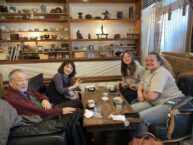My CIP is to volunteer in a kindergarten called みつば幼稚園. My experience at the kindergarten playing with kids is definitely memorable and treasurable to me. I chose to engage in volunteering activity in a kindergarten because I always loved to play and talk with little kids. As a foreigner and also with my level of Japanese proficiency, I always feel that other Japanese university students of my age are nervous or even slightly scared to engage in conversations with me. Also, since Japanese people are known for their modesty and politeness, they are not so likely to correct me when I make mistakes in Japanese. However, kids tend to be more straight forward and they always talk to me in the most-casual way of speech in Japanese, which I enjoy talking with them a lot.
Before I engaged in this CIP activity, I expected kids to be speaking in really simple, easy Japanese, and I most likely would be able to understand most part of what they are saying. But I was wrong! I realized that kids tend to talk really fast, and they always ask なんで、どうして、なぜto everything I say, which I find it really funny. For instance, they asked why my hair is brown? Why do I have accent when speaking Japanese? My task in the kindergarten was basically to play with the kids, literally just to PLAY with them. In this process, I was able to practice my Japanese a lot from talking with them. It was an interesting experience to be a 「先生」at the kindergarten. Everyone in the kindergarten calls me ゆいせんせいthere. Although the kids call me sensei, I can tell that they see me more like a big sister or friend from the way they talk and play with me. It is funny that the kids actually do not understand the fact that I am a 外国人. Since I am not fluent in Japanese, I make mistakes a lot and my Japanese has accent. Whenever I say something wrong in Japanese, the kids will always correct. I remember having a hard time to say ケチャップin its right Japanese intonation, and a kid made me pronounce the word again and again till I can say it perfectly. I was questioned of my strange Japanese intonation once by a kid, who asked なぜ発音そんなにおかしいの、外国人みたい!That was very funny but it truly made my day. I recommend this CIP activity a lot because you get help for Japanese from young 先生達 a lot even though you are actually the “teacher.” The kids were never hesitant with correcting my mistakes, and I really love my experience with this CIP.
I definitely learned a lot from this CIP experience and was also able to make wonderful memories that I will take with me forever. It is indeed important to find a CIP that you truly enjoy. Although CIP is part of the curriculum’s requirement, it should never be something that adds up to your burden or stresses you. In fact, CIP should be something that you find joy doing it. When searching for a CIP, know what your passion is and what is something that always gives you a good time. Simply enjoy your time with the community involved in your CIP! Although our time in Japan is limited but the experience and relationships that we build though CIP is timeless.

